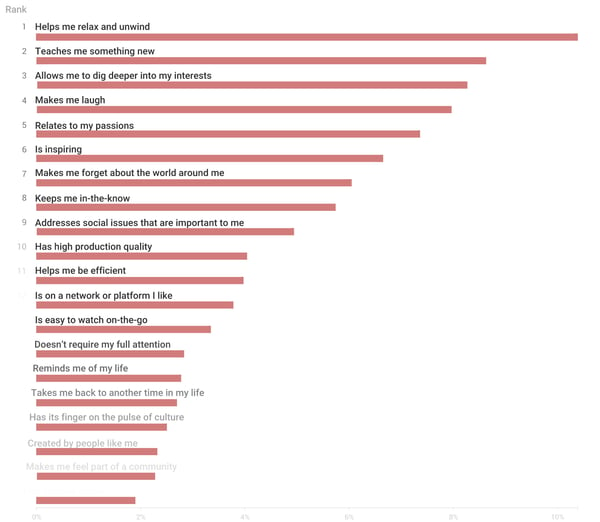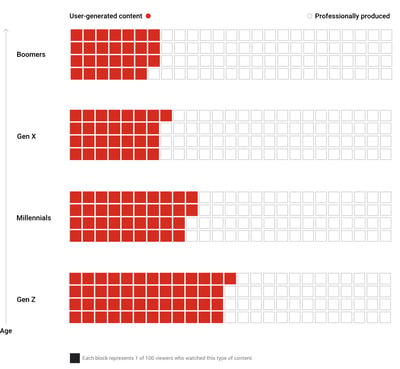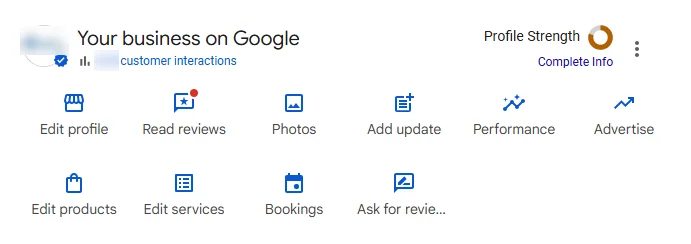In 2020, video is more important to consumers than ever before.
Each day, we stream our favorite shows, watch explainer videos on YouTube to learn something new, or follow events, Q&As, and interviews via live video.
Unsurprisingly, video content's current popularity is due in part to millennial and Gen Z consumers. These age groups are more connected to the internet than older age groups,, and prefer to be entertained or learn new things from online videos.
At this point, marketers know that they should be leveraging video in their marketing strategy. According to HubSpot's 2020 State of Marketing report, video beat out heavyweight contenders like email, blogging, and infographics as the most used type of marketing content.
The interest in video isn't surprising or new. Throughout the last century, we've seen video move from black and white televisions to smartphones and tablets. As consumers have seen this content become more available at our fingertips, brands have discovered a number of new ways to implement video in their marketing.
Now, rather than relying on a commercial during our favorite sitcoms to learn about a product, we're inundated with marketing videos all over social media, streaming apps, and search result pages.
Video isn't going anywhere, but it is always expanding, changing, and evolving to fit new consumer needs and new platforms.
As this content continues to evolve with each new generation, marketers should continue researching video consumers' interests, hobbies, and behaviors.
In this blog post, I'll highlight six research-backed ways video consumption habits are changing and how marketers can respond strategically.
How Video Consumption is Changing in 2020
1. Consumers are beginning to rely on marketing videos from brands.
In the past, consumers would visit websites, look at online reviews, watch commercials, and maybe search out a few YouTube videos to learn about a product. Now, with video being accessible on every major social media network, they are learning to rely more heavily on this type of content in their research phase.
While brands are seeing higher engagement than ever from video marketing, consumers increasingly expect to see this type of content from brands. Even back in 2018, a whopping 87% of consumers said they wanted to see more video from brands in the next year.
In 2020, it's likely that the expectation of brands to provide marketing videos has gotten even stronger. Each day, consumers use product demos, video reviews, and unboxings to learn about products before they buy them.
What do increasing video content expectations mean for you as a marketer? Well, if a prospect is interested in a product or service in your industry, looks for video reviews or tutorials, and can't find any related to your brand's offering, they might buy a product from another brand.
Why? Videos give consumers the opportunity to see how a product or service works in real life, discover any flaws before purchasing the item, and identify perks that they might not learn about in the text-based description. This content might also appear to be more authentic than a heavily edited product shot, which can boost a consumer's trust in a brand or offering.
2. Half of Gen Z and Millennials “don't know how they'd get through life without video.”
To some, this isn't that much of a shock. Each new generation has watched more online video than the last. However, when it comes to those under the age of 34, videos have more of an impact on daily life than ever before. In YouTube's survey, 50% of people in both generations said they “couldn't live” without video in their daily lives.
Aside from using video for entertainment, both millennials and Gen Z prefer to watch videos for information gathering purposes. Even when it comes to learning about a new brand or product, these age groups prefer video explainers, product demos, or other marketing videos to simply reading about a company online.
With millennials nearing 40 and Gen Z beginning to gain full purchasing power, there's a good chance that these two age groups will take up a major portion of your audience soon if they aren't already.
At this point, marketers aiming to attract these two generations should consider testing out video strategies on social media or their own websites. While these age groups might regularly use video for entertainment purposes, it's also likely that they'll use it to learn more about products or brands worth investing in. If there's a great video recommendation or tutorial out there for a product they're interested in, they might find it, watch it, and use that content to confirm that this purchase is right for them.
3. Video consumers want to relax — or escape — from daily life.
In the past, older generations might have turned on their favorite TV sitcom or gone to the movies to escape from the stresses of daily life. While the platforms have changed as younger consumers take over the video market, the instinctive need for relaxing or entertaining content hasn't.
When asked to rank the reasons why consumers watch video content, YouTube survey participants said they primarily watch videos in order to, “relax and unwind.” Additionally, the fourth most common reason that people watch videos is that the content makes them laugh. Additionally, people cited, “Makes me forget about the world around me,” as the seventh most common reason for watching videos.

Image Source
As a marketer, you shouldn't put all of your time and money into just creating mindless content that will relax your viewers or give them a laugh. But, you can keep in mind that many viewers are still looking to be entertained or intrigued by your content.
Even when you're creating an informative marketing video, you can consider experimenting with funny anecdotes or adding other entertaining qualities. Interested in adding fun elements to your next marketing video? Get inspired by major brands that effectively used humor in their marketing.
4. Consumers want to learn more about their niche and passions.
Aside from looking for escapism, YouTube viewers are motivated to watch content that teaches them new things, especially when related to their passions, interests, hobbies, or social causes. While the second most common reasoning for watching a video was it, “teaches me something new,” people also said they prioritize content that allows them to “dig deeper” into their interests or “relates to” their passions.
Odds are your product relates to someone's interests, hobbies, passions, or career. This is the type of person you'll want to watch and enjoy your videos.
Creating a buyer persona and target audience around this type of person will help you identify video topics that they'll value, benefit from, and remember your brand for publishing.
5. Consumers don't care if your video looks like it has a big budget.
There's a common misconception that marketing videos need to feature the biggest Hollywood stars and must be shot in a high-priced studio. In 2020, as marketers are increasingly producing video remotely, this myth has definitely been debunked.
But, if the evolving video marketing workforce hasn't convinced you that low-budget videos can still be effective, here's what YouTube discovered in its survey:
When asking consumers to rank the top reasons they watched videos, surprisingly “high production quality,” and “famous actors” neared the bottom of the list.

Image Source
Aside from ranking high-budget video features as the least likely reasons for watching videos, millennials and Gen Z differ from older age groups in that they're more accepting of user-generated content over professionally made videos. This might hint that brands can leverage content created by their own customers or fans when creating marketing videos:

Image Source
At this point, there are plenty of ways to produce an affordable video with solid quality from any home or workspace. And, while it will still take time and money to launch this content, effective marketing videos made anywhere can boost your level of brand awareness.
6. Younger generations are watching longer content.
The average Gen Z member has an online attention span of eight seconds. That's four seconds less than millennials. But although Gen Z's attention span for general online surfing might be quite short, long-form videos that interest them can grasp their attention — and keep it.

Image Source
The adoption of long-form content with each new generation isn't new. According to YouTube's study, millennials also watched longer-form videos more often than their Gen X predecessors.
As a marketer, you'll need to keep the attention spans of each new generation in mind as you set the pace for your video content.
Your video has mere seconds to catch a millennial or Gen Z member's attention as they're aimlessly scrolling through a social media feed. However, if your video captures viewers immediately and then continues to offer entertaining, valuable, or interesting information throughout, these age groups might watch the whole thing — even if it is on the longer side.
Before you put a marketing video online, re-watch it from the point-of-view of a somewhat busy consumer. Then, ask yourself, “Does this video pull viewers into the action quickly and keep their attention?” If you're worried that parts of your video seem dull, you might want to shorten it. But, if your team thinks it's entertaining or informative the entire time, you can experiment with publishing your longer-form video and learning from its results.
Navigating Video in 2020
With each new generation, the video world will continue to evolve.
However, at this point, the video landscape is changing in favor of marketers. Not only do consumers prefer to learn about brands via video content, but they use it as a necessary tool in the information-gathering phase of their buyer's journey.
Additionally, the vast majority of video consumers now strive to learn something new about an interest or hobby, rather than just using video to entertain themselves. This means marketers can harness educational videos in their strategy and offer consumers content that relates to their niche, while also marketing a brand or product.
In 2020, you don't need a high-priced video budget to succeed as a marketer. You just need to create content that engages, educates, and intrigues your audience.
To learn more about how to create a winning marketing video — even on a budget — check out this how-to post. For tactical promotional tips, check out The Ultimate Guide to Video Marketing.
![]()





Recent Comments